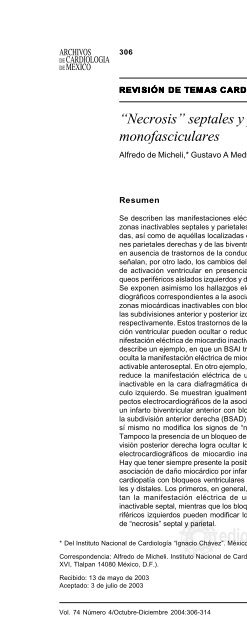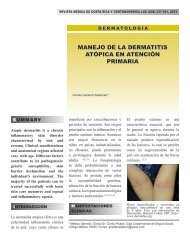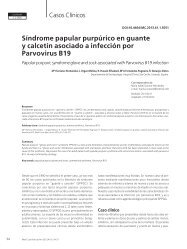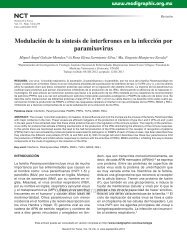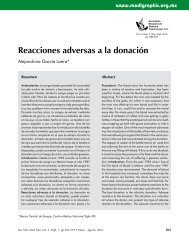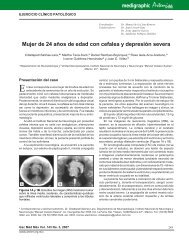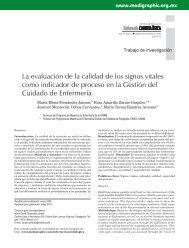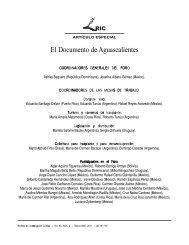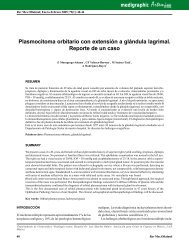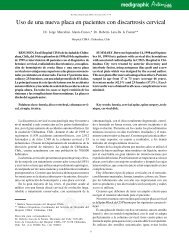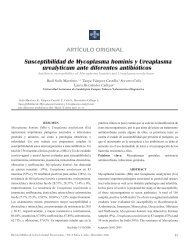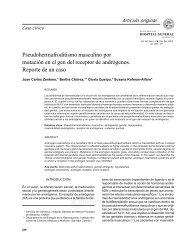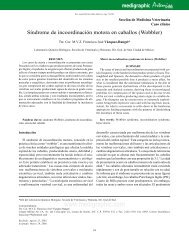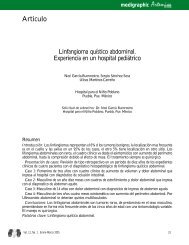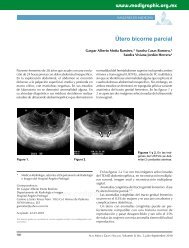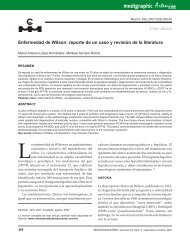“Necrosis” septales y parietales con bloqueos ... - edigraphic.com
“Necrosis” septales y parietales con bloqueos ... - edigraphic.com
“Necrosis” septales y parietales con bloqueos ... - edigraphic.com
You also want an ePaper? Increase the reach of your titles
YUMPU automatically turns print PDFs into web optimized ePapers that Google loves.
306<br />
Resumen<br />
<strong>edigraphic</strong>.<strong>com</strong><br />
* Del Instituto Nacional de Cardiología “Ignacio Chávez”. México.<br />
Correspondencia: Alfredo de Micheli. Instituto Nacional de Cardiología “Ignacio Chávez“ (INCICH, Juan Badiano No. 1 Col. Sección<br />
XVI, Tlalpan 14080 México, D.F.).<br />
Recibido: 13 de mayo de 2003<br />
Aceptado: 3 de julio de 2003<br />
REVISIÓN REVISIÓN DE DE DE TEMAS TEMAS CARDIOLÓGICOS<br />
CARDIOLÓGICOS<br />
<strong>“Necrosis”</strong> <strong>septales</strong> y <strong>parietales</strong> <strong>con</strong> <strong>bloqueos</strong> periféricos<br />
monofasciculares<br />
Alfredo de Micheli,* Gustavo A Medrano*<br />
Se describen las manifestaciones eléctricas de<br />
zonas inactivables <strong>septales</strong> y <strong>parietales</strong> izquierdas,<br />
así <strong>com</strong>o de aquéllas localizadas en regiones<br />
<strong>parietales</strong> derechas y de las biventriculares,<br />
en ausencia de trastornos de la <strong>con</strong>ducción. Se<br />
señalan, por otro lado, los cambios del proceso<br />
de activación ventricular en presencia de <strong>bloqueos</strong><br />
periféricos aislados izquierdos y derechos.<br />
Se exponen asimismo los hallazgos electrocardiográficos<br />
correspondientes a la asociación de<br />
zonas miocárdicas inactivables <strong>con</strong> <strong>bloqueos</strong> de<br />
las subdivisiones anterior y posterior izquierdas,<br />
respectivamente. Estos trastornos de la <strong>con</strong>ducción<br />
ventricular pueden ocultar o reducir la manifestación<br />
eléctrica de miocardio inactivable. Se<br />
describe un ejemplo, en que un BSAI transitorio<br />
oculta la manifestación eléctrica de miocardio inactivable<br />
anteroseptal. En otro ejemplo, un BSPI<br />
reduce la manifestación eléctrica de una zona<br />
inactivable en la cara diafragmática del ventrículo<br />
izquierdo. Se muestran igualmente los aspectos<br />
electrocardiográficos de la asociación de<br />
un infarto biventricular anterior <strong>con</strong> bloqueo de<br />
la subdivisión anterior derecha (BSAD), que por<br />
sí mismo no modifica los signos de “necrosis”.<br />
Tampoco la presencia de un bloqueo de la subdivisión<br />
posterior derecha logra ocultar los signos<br />
electrocardiográficos de miocardio inactivable.<br />
Hay que tener siempre presente la posibilidad de<br />
asociación de daño miocárdico por infarto o miocardiopatía<br />
<strong>con</strong> <strong>bloqueos</strong> ventriculares proximales<br />
y distales. Los primeros, en general, no ocultan<br />
la manifestación eléctrica de una zona<br />
inactivable septal, mientras que los <strong>bloqueos</strong> periféricos<br />
izquierdos pueden modificar los signos<br />
de “necrosis” septal y parietal.<br />
Vol. 74 Número 4/Octubre-Diciembre 2004:306-314 MG<br />
Summary<br />
SEPTAL AND PARIETAL DEAD MYOCARDIUM WITH<br />
PERIPHERAL MONOFASCICULAR BLOCKS<br />
We describe the electrical manifestations of dead<br />
left septal, left and right parietal myocardium and<br />
those of biventricular location, reviewing the electrocardiographic<br />
signs of the isolated left and right<br />
peripheral blocks. We also describe the electrical<br />
manifestations of dead myocardium ac<strong>com</strong>panied<br />
by a left anterior subdivision block (LASB)<br />
and a left posterior subdivision block (LPSB).<br />
These ventricular <strong>con</strong>duction disorders can reduce<br />
or <strong>con</strong>ceal the electrical manifestation of<br />
the dead zone. We present a case in which a<br />
transient LASB <strong>con</strong>ceals the electrical manifestation<br />
of dead anteroseptal myocardium. The<br />
association of diaphragmatic dead myocardium<br />
with LPSB reduces the electrocardiographic<br />
manifestation of dead tissue. We show the electrocardiographic<br />
findings obtained in a case of a<br />
biventricular anterior infarct with a right anterior<br />
subdivision block (RASB), as well as an ECG<br />
corresponding to the association of a dead myocardial<br />
zone with a right posterior subdivision<br />
block (RPSB). These ventricular <strong>con</strong>duction disorders<br />
do not generally <strong>con</strong>ceal the electrocardiographic<br />
signs of dead myocardial tissue. The<br />
possible association of myocardial damage due<br />
to an infarct or a myocardiopathy with ventricular<br />
proximal and peripheral blocks must be kept<br />
in mind. Besides, it is important to <strong>con</strong>sider that<br />
proximal blocks do not modify substantially the<br />
signs of dead myocardial tissue, whereas peripheral<br />
blocks can reduce or <strong>con</strong>ceal these signs.<br />
(Arch Cardiol Mex 2004; 74:306-314).


